Sorption of Differently Charged Gold Nanoparticles on Synthetic Pyrite
Abstract
1. Introduction
2. Materials and Methods
2.1. Reagents
2.2. Synthesis and Characterization of Gold Colloids
2.3. Synthesis, Characterization, and Pretreatment of Pyrite
2.4. Sorption and Desorption Experiments
3. Results and Discussion
3.1. Characterization of Synthesized AuNPs and Pyrite
3.2. Effect of AuNPs Charge Characteristics on Sorption Behaviors
3.3. Effect of CTAB Concentration on the Sorption of Positively Charged AuNPs
3.4. Effect of Ionic Strength on the Sorption of Positively Charged AuNPs
3.5. Desorption of Positively Charged AuNPs
4. Conclusions
Supplementary Materials
Author Contributions
Funding
Conflicts of Interest
References
- Hochella, M.F.; Lower, S.K.; Maurice, P.A.; Penn, R.L.; Sahai, N.; Sparks, D.L.; Twining, B.S. Nanominerals, mineral nanoparticles, and earth systems. Science 2008, 319, 1631–1635. [Google Scholar] [CrossRef] [PubMed]
- Trun, L.; Bañares, M.A. Advances in Experimental Medicine and Biology; Cohen, I.R., Ed.; Springer: Berlin/Heidelberg, Germany, 2016; pp. 1–360. [Google Scholar]
- Kelle, A.A.; McFerran, S.; Lazareva, A.; Suh, S. Global life cycle releases of engineered nanomaterials. J. Nanopart. Res. 2013, 15, 1692–1708. [Google Scholar] [CrossRef]
- Fenter, P.; Sturchio, N.C. Mineral-water interfacial structures revealed by synchrotron X-ray scattering. Prog. Surf. Sci. 2004, 77, 171–258. [Google Scholar] [CrossRef]
- Stumm, W. Chemistry of the Solid-Water Interface; John Wiley & Sons, Inc.: Hoboken, NJ, USA, 1992; pp. 1–432. [Google Scholar]
- Mikhlin, Y.; Romanchenko, A.; Likhatsk, M.; Karacharov, A.; Erenburg, S.; Trubina, S. Understanding the initial stages of precious metals precipitation: Nanoscale metallic and sulfidic species of gold and silver on pyrite surfaces. Ore Geol. Rev. 2011, 42, 47–54. [Google Scholar] [CrossRef]
- Gupta, G.S.; Senapati, V.A.; Dhawan, A.; Shanker, R. Heteroagglomeration of zinc oxide nanoparticles with clay mineral modulates the bioavailability and toxicity of nanoparticle in Tetrahymena pyriformis. J. Colloid Interf. Sci. 2017, 495, 9–18. [Google Scholar] [CrossRef] [PubMed]
- Smith, B.M.; Pike, D.J.; Kelly, M.O.; Nason, J.A. Quantification of Heteroaggregation between Citrate-Stabilized Gold Nanoparticles and Hematite Colloids. Environ. Sci. Technol. 2015, 49, 12789–12799. [Google Scholar] [CrossRef] [PubMed]
- Chiu, C.W.; Ou, G.B.; Tsai, Y.H.; Lin, J.J. Immobilization of silver nanoparticles on exfoliated mica nanosheets to form highly conductive nanohybrid films. Nanotechnology 2015, 26. [Google Scholar] [CrossRef] [PubMed]
- Park, Y.C.; Paulsen, J.; Nap, R.J.; Whitaker, D.R.; Mathiyazhagan, V.; Song, Y.Q.; HüRlimann, M.; Szleifer, I.; Wong, J.Y. Adsorption of superparamagnetic iron oxide nanoparticles on silica and calcium carbonate sand. Langmuir 2014, 30, 784–792. [Google Scholar] [CrossRef] [PubMed]
- Alex, S.; Tiwari, A. Functionalized gold nanoparticles: Synthesis, properties and applications—A review. J. Nanosci. Nanotechnol. 2015, 15, 1869–1894. [Google Scholar] [CrossRef] [PubMed]
- Tiede, K.; Hassellöv, M.; Breitbarth, E.; Chaudhry, Q.; Boxall, A.B.A. Considerations for environmental fate and ecotoxicity testing to support environmental risk assessments for engineered nanoparticles. J. Chromatogr. A 2009, 1216, 503–509. [Google Scholar] [CrossRef] [PubMed]
- Tiede, K.; Boxall, A.B.A.; Tear, S.P.; Lewis, J.; David, H.; Hassellöv, M. Detection and characterization of engineered nanoparticles in food and the environment. Food. Addit. Contam. 2008, 7, 795–821. [Google Scholar] [CrossRef] [PubMed]
- Wang, Y.F. Nanogeochemistry: Nanostructures, emergent properties and their control on geochemical reactions and mass transfers. Chem. Geol. 2014, 378, 1–23. [Google Scholar] [CrossRef]
- Palenik, C.S.; Utsunomiya, S.; Reich, M.; Kesler, S.E.; Wang, L.; Ewing, R.C. “Invisible” gold revealed: Direct imaging of gold nanoparticles in a Carlin-type deposit. Am. Mineral. 2004, 89, 1359–1366. [Google Scholar] [CrossRef]
- Hough, R.M.; Noble, R.R.P.; Reich, M. Natural gold nanoparticles. Ore Geol. Rev. 2011, 42, 55–61. [Google Scholar] [CrossRef]
- Reich, M.; Kesler, S.E.; Utsunomiya, S.; Palenik, C.S.; Chryssoulis, S.L.; Ewing, R.C. Solubility of gold in arsenian pyrite. Geochim. Cosmochim. Acta 2005, 11, 2781–2796. [Google Scholar] [CrossRef]
- Romanchenko, A.S.; Mikhlin, Y.L.; Makhova, L.V. Investigation of Gold Nanoparticles Immobilized on the Surface of Pyrite by Scanning Probe Microscopy, Scanning Tunneling Spectroscopy, and X-ray photoelectron Spectroscopy. Glass Phys. Chem. 2007, 4, 417–421. [Google Scholar] [CrossRef]
- Muntean, J.L.; Cline, J.S.; Simon, A.C.; Longo, A.A. Magmatic-hydrothermal origin of Nevada’s Carlin-type gold deposits. Nat. Geosci. 2011, 4, 122–127. [Google Scholar] [CrossRef]
- Fougerouse, D.; Reddy, S.M.; Saxey, D.W.; Rickard, W.D.A.; Van Riessen, A.; Micklethwaite, S. Nanoscale gold clusters in arsenopyrite controlled by growth rate not concentration: Evidence from atom probe microscopy. Am. Mineral. 2016, 101, 1916–1919. [Google Scholar] [CrossRef]
- Eghbalnia, M. Electrochemical and Raman Investigation of Pyrite and Chalcopyrite Oxidation. Ph.D. Thesis, University of British Columbia, Vancouver, BC, Canada, April 2012. Available online: https://open.library.ubc.ca/cIRcle/collections/ubctheses/24/items/1.0072701 (accessed on 25 September 2018).
- Chandra, A.P.; Gerson, A.R. The mechanisms of pyrite oxidation and leaching: A fundamental perspective. Surf. Sci. Rep. 2010, 65, 293–315. [Google Scholar] [CrossRef]
- Fu, Y.H.; Nie, X.; Qin, Z.H.; Li, S.S.; Wan, Q. Effect of Particle Size and Pyrite Oxidation on the Sorption of Gold Nanoparticles on the Surface of Pyrite. J. Nanosci. Nanotechnol. 2017, 17, 6367–6376. [Google Scholar] [CrossRef]
- Duan, Y.H.; Han, D.S.; Batchelor, B.; Abdel-Wahab, A. Synthesis, characterization, and application of pyrite for removal of mercur. Colloid Surf. A 2016, 490, 326–335. [Google Scholar] [CrossRef]
- Lau, B.L.T.; Huang, R.X.; Madden, A.S. Electrostatic adsorption of hematite nanoparticles on self-assembled monolayer surfaces. J. Nanopart. Res. 2013, 15, 1873–1882. [Google Scholar] [CrossRef]
- Frens, G. Controlled nucleation for the regulation of the particle size in monodisperse gold suspensions. Nat. Phys. Sci. 1973, 105, 20–22. [Google Scholar] [CrossRef]
- Sau, T.K.; Murphy, S.C. Room Temperature, High-Yield Synthesis of Multiple Shapes of Gold Nanoparticles in Aqueous Solution. J. Am. Chem. Soc. 2004, 126, 8648–8649. [Google Scholar] [CrossRef] [PubMed]
- Wang, J.; Li, Y.F.; Huang, C.Z.; Wu, T. Rapid and selective detection of cysteine based on its induced aggregates of cetyltrimethylammonium bromide capped gold nanoparticles. Anal. Chim. Acta 2008, 626, 37–43. [Google Scholar] [CrossRef] [PubMed]
- Khan, Z.; Singh, T.; Hussain, J.I.; Hashmi, A.A. Au(III)-CTAB reduction by ascorbic acid: Preparation and characterization of gold nanoparticles. Colloid Surf. B 2013, 104, 11–17. [Google Scholar] [CrossRef] [PubMed]
- Yang, Z.T.; Liu, X.J.; Feng, X.L.; Cui, Y.X.; Yang, X.W. Hydrothermal synthesized micro/nano-sized pyrite used as cathode material to improve the electrochemical performance of thermal battery. J. Appl. Electrochem. 2014, 44, 1075–1080. [Google Scholar] [CrossRef]
- Descostes, M.; Vitorge, P.; Beaucaire, C. Pyrite dissolution in acidic medi. Geochim. Cosmochim. Acta 2004, 22, 4559–4569. [Google Scholar] [CrossRef]
- Feng, B.; Lu, Y.P.; Luo, X.P. The effect of quartz on the flotation of pyrite depressed by serpentine. J. Mater. Res. Technol. 2015, 4, 8–13. [Google Scholar] [CrossRef]
- Hu, X.M.; Yang, S.S. Spectrophotometric method for determination of cetyltrimethyl-ammonium bromide in water. Adm. Technol. Environ. Monit. 2010, 5, 45–47. [Google Scholar]
- Badawy, A.M.E.; Luxton, T.P.; Silva, R.G.; Scheckel, K.G.; Suidan, M.T. Impact of environmental conditions (pH, ionic strength, and electrolyte type) on the surface charge and aggregation of silver nanoparticles suspensions. Environ. Sci. Technol. 2010, 44, 1260–1266. [Google Scholar] [CrossRef] [PubMed]
- Lide, D.R. CRC Handbook of Chemistry and Physics; Taylor and Francis Boca Raton FL: Boca Raton, FL, USA, 2007; pp. 1–2560. [Google Scholar]
- Hamon, C.; Bizien, T.; Artzner, F.; Even-Hernandez, P.; Marchi, V. Replacement of CTAB with peptidic ligands at the surface of gold nanorods and their self-assembling properties. J. Colloid Interface Sci. 2014, 424, 90–97. [Google Scholar] [CrossRef] [PubMed]
- Kosmulski, M. Surface Charging and Points of Zero Charge; Kosmulski, M., Ed.; Taylor and Francis Boca Raton FL: Boca Raton, FL, USA, 2009; pp. 1–1094. [Google Scholar]
- Fornasiero, D.; Eijt, V.; Ralston, J. An electrokinetic study of pyrite oxidation. Colloids Surfaces 1992, 62, 63–73. [Google Scholar] [CrossRef]
- Monfared, A.D.; Ghazanfari, M.H.; Jamialahmadi, M.; Helalizadeh, A. Adsorption of silica nanoparticles onto calcite: Equilibrium, kinetic, thermodynamic and DLVO analysis. Chem. Eng. J. 2015, 281, 334–344. [Google Scholar] [CrossRef]
- Peng, C.; Zhang, W.; Gao, H.P.; Li, Y.; Tong, X.; Li, K.G.; Zhu, X.S.; Wang, Y.X.; Chen, Y.S. Behavior and potential impacts of metal-based engineered nanoparticles in aquatic environments. Nanomaterials 2017, 7, 21. [Google Scholar] [CrossRef] [PubMed]
- Johnson, C.A.; Lenhoff, A.M. Adsorption of charged latex particles on mica studied by atomic force microscopy. J. Colloid Interface Sci. 1996, 179, 587–599. [Google Scholar] [CrossRef]
- Sadowska, M.; Adamczyk, Z.; Nattich-Rak, M. Mechanism of nanoparticle deposition on polystyrene latex particles. Langmuir 2014, 30, 692–699. [Google Scholar] [CrossRef] [PubMed]
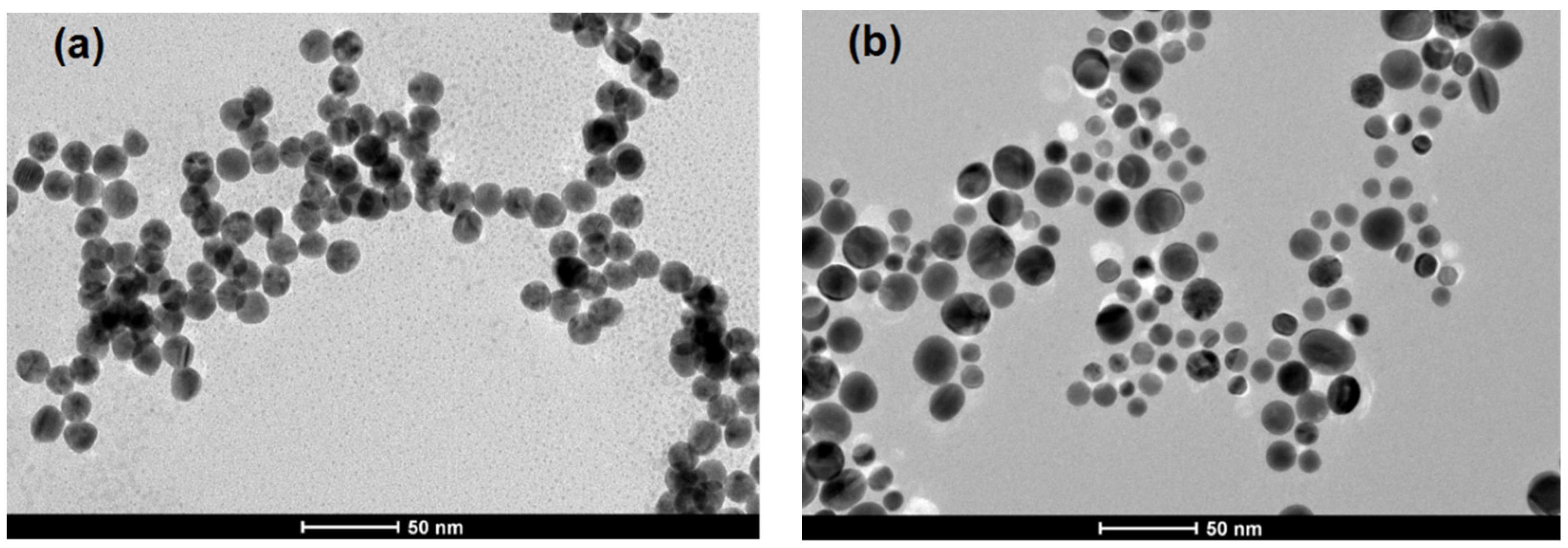
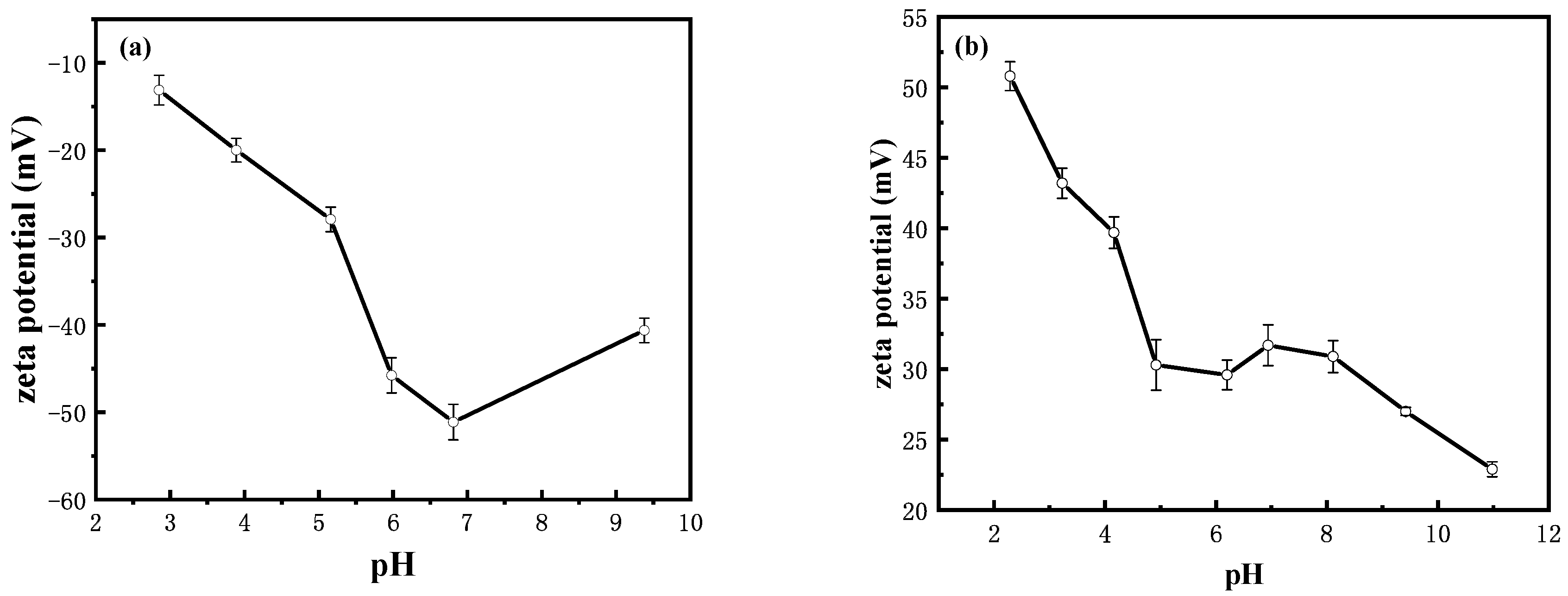
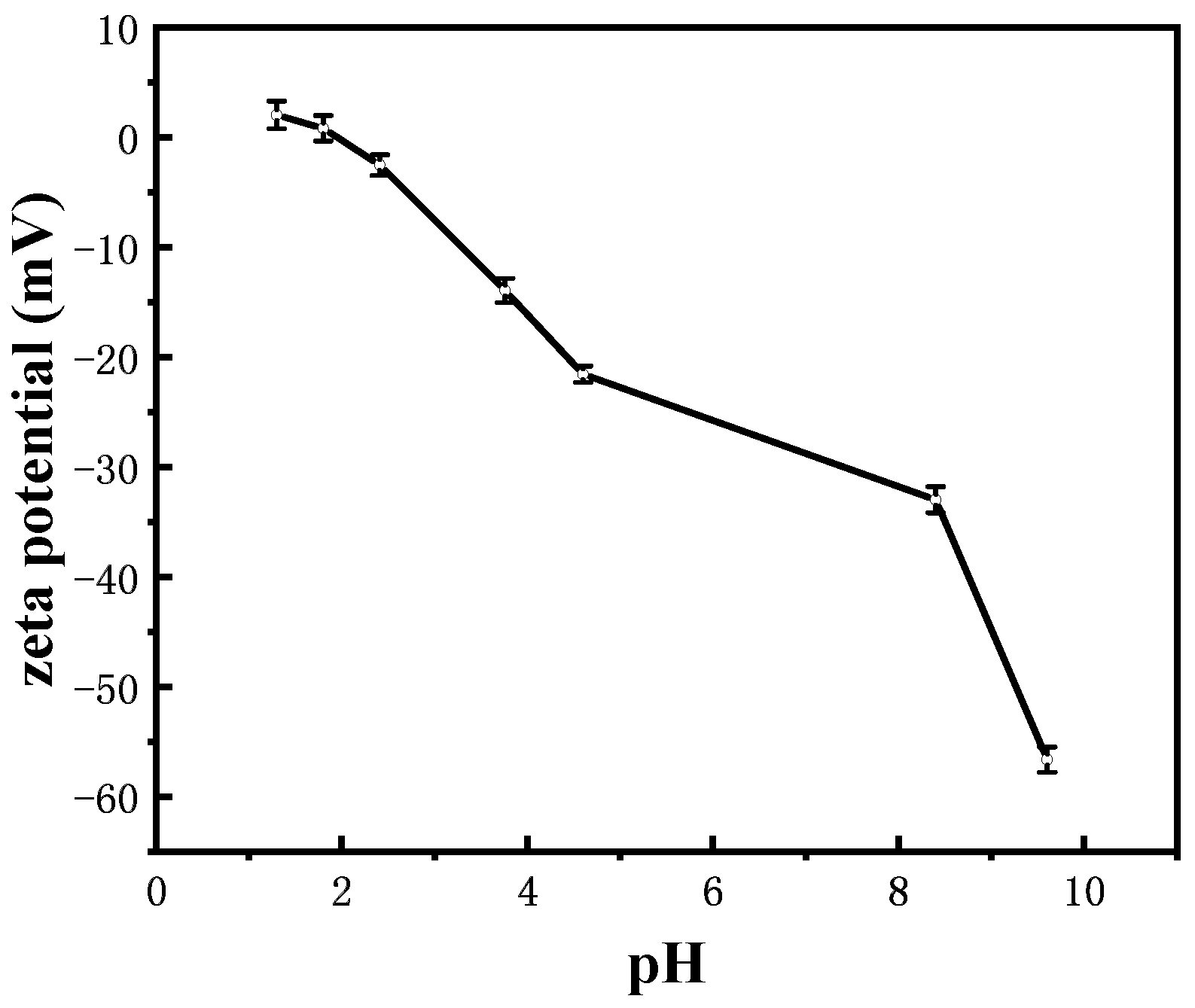
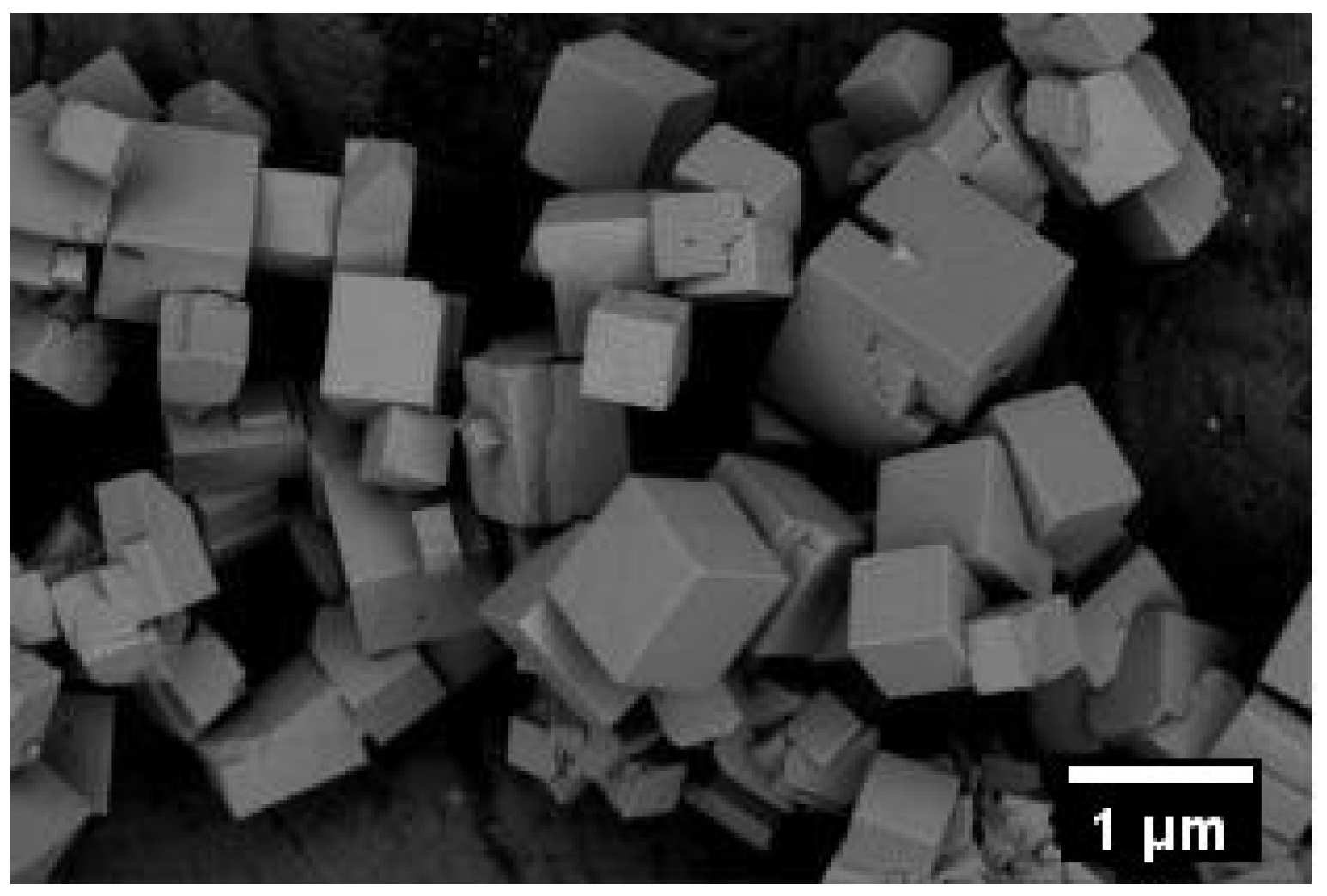
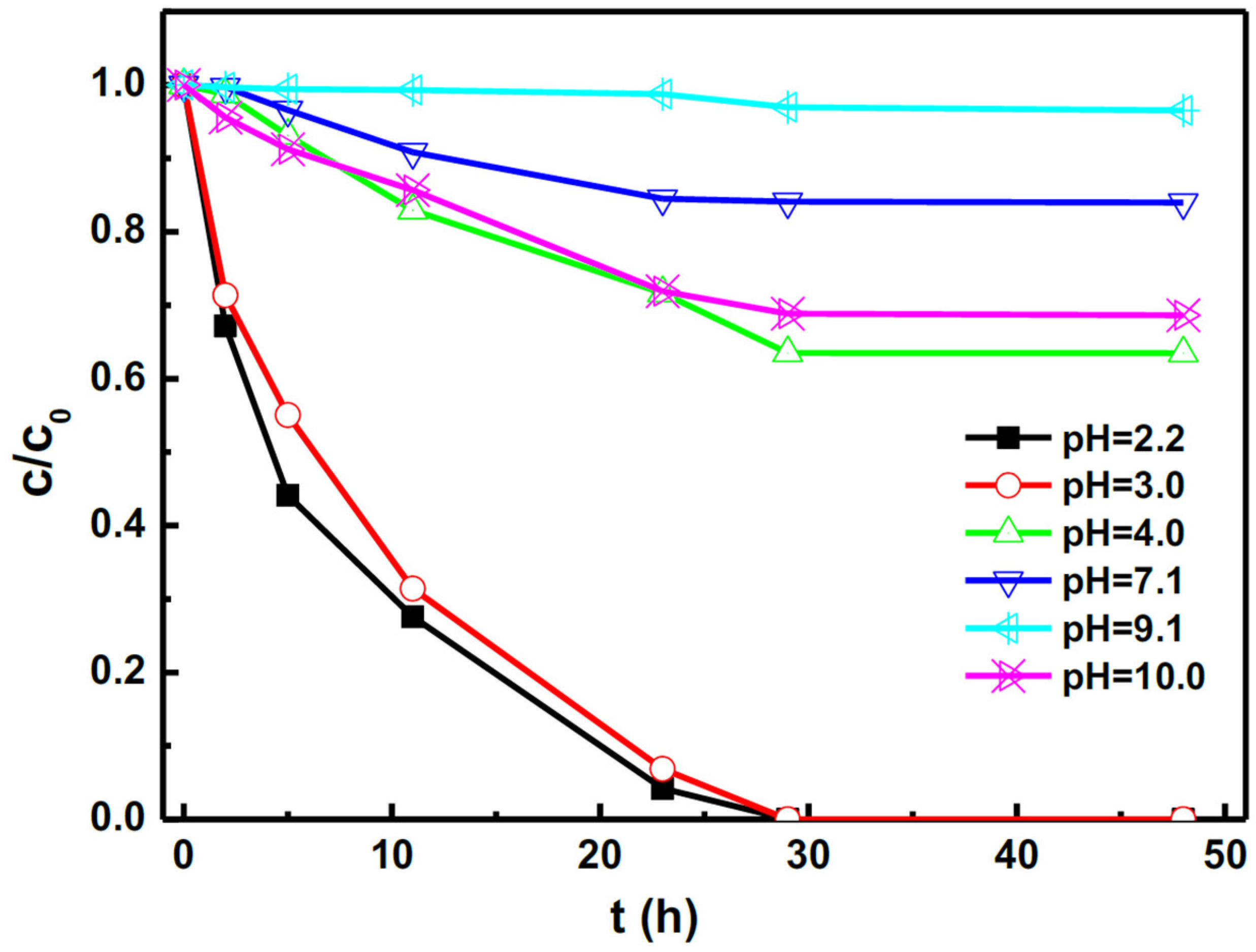


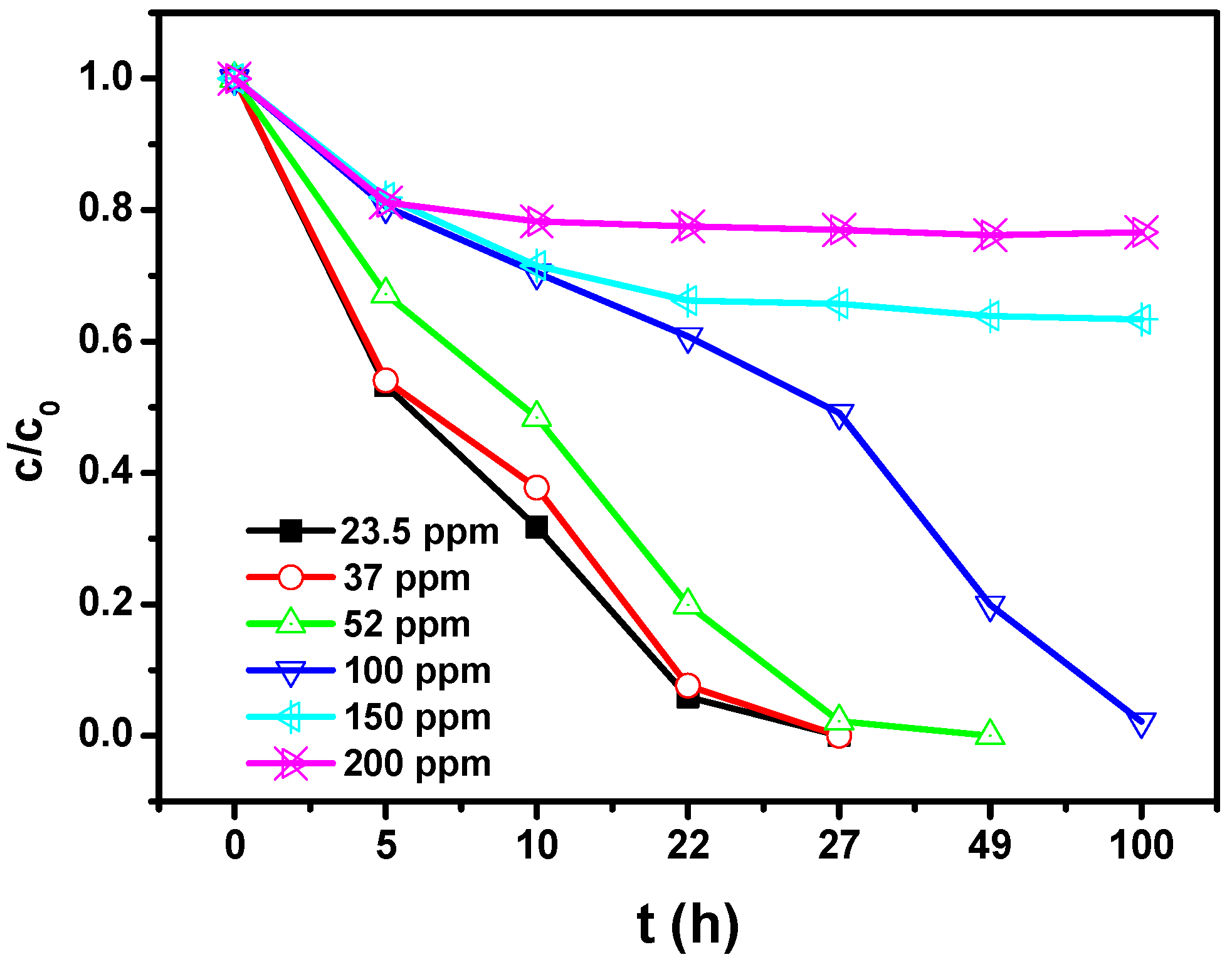
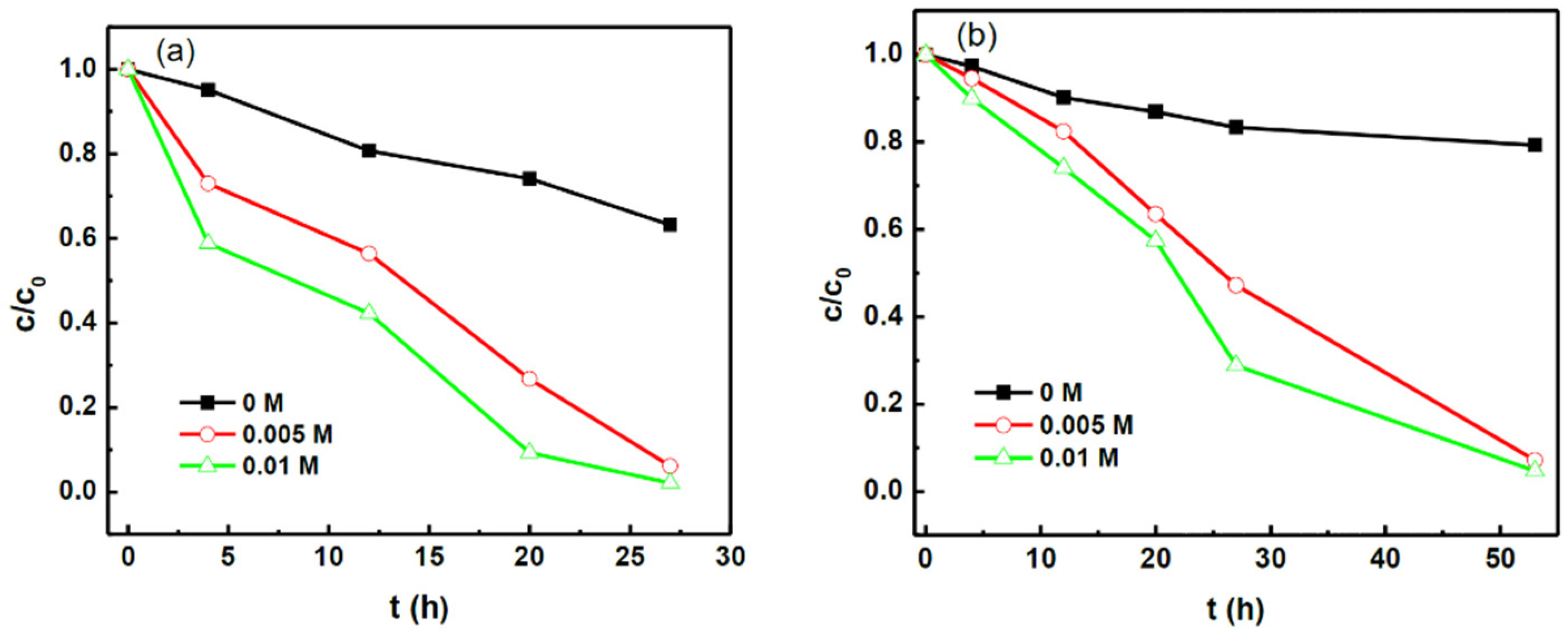
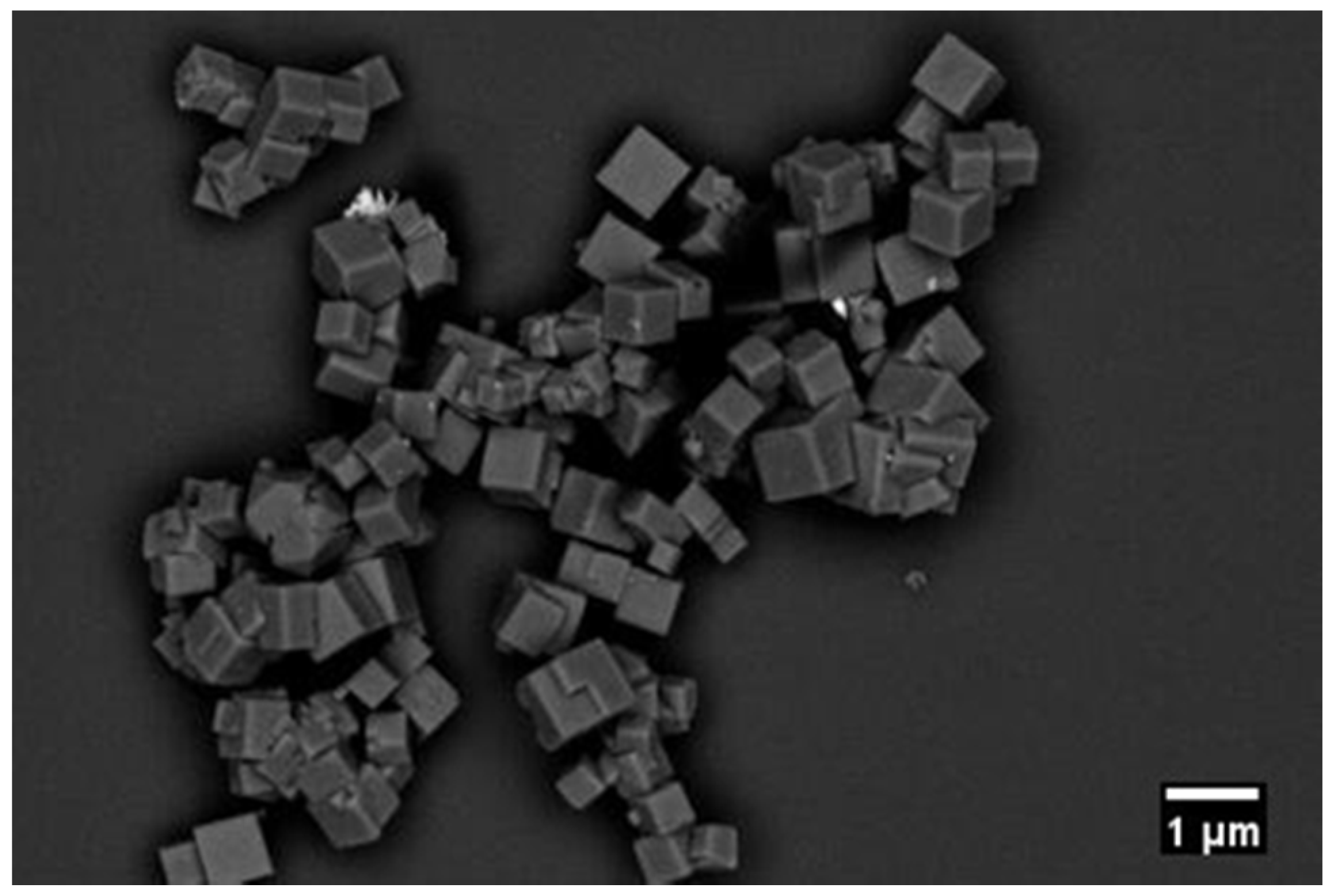
© 2018 by the authors. Licensee MDPI, Basel, Switzerland. This article is an open access article distributed under the terms and conditions of the Creative Commons Attribution (CC BY) license (http://creativecommons.org/licenses/by/4.0/).
Share and Cite
Luo, S.; Nie, X.; Yang, M.; Fu, Y.; Zeng, P.; Wan, Q. Sorption of Differently Charged Gold Nanoparticles on Synthetic Pyrite. Minerals 2018, 8, 428. https://doi.org/10.3390/min8100428
Luo S, Nie X, Yang M, Fu Y, Zeng P, Wan Q. Sorption of Differently Charged Gold Nanoparticles on Synthetic Pyrite. Minerals. 2018; 8(10):428. https://doi.org/10.3390/min8100428
Chicago/Turabian StyleLuo, Suxing, Xin Nie, Meizhi Yang, Yuhong Fu, Ping Zeng, and Quan Wan. 2018. "Sorption of Differently Charged Gold Nanoparticles on Synthetic Pyrite" Minerals 8, no. 10: 428. https://doi.org/10.3390/min8100428
APA StyleLuo, S., Nie, X., Yang, M., Fu, Y., Zeng, P., & Wan, Q. (2018). Sorption of Differently Charged Gold Nanoparticles on Synthetic Pyrite. Minerals, 8(10), 428. https://doi.org/10.3390/min8100428




